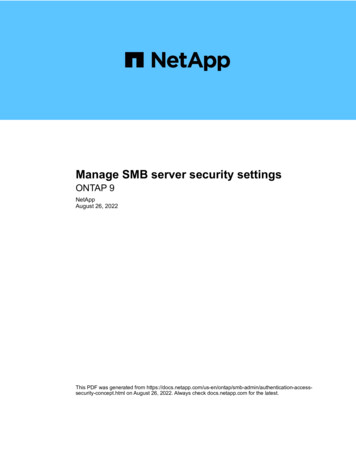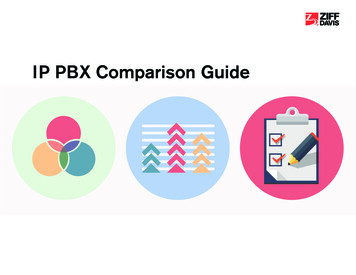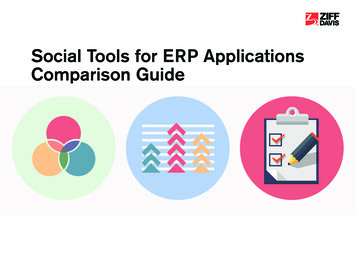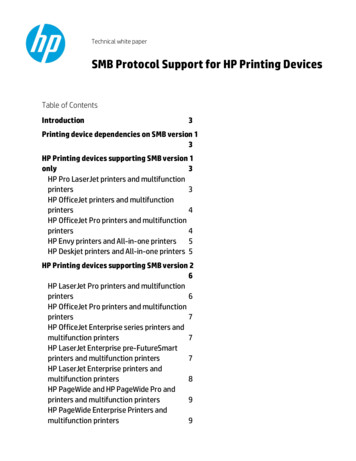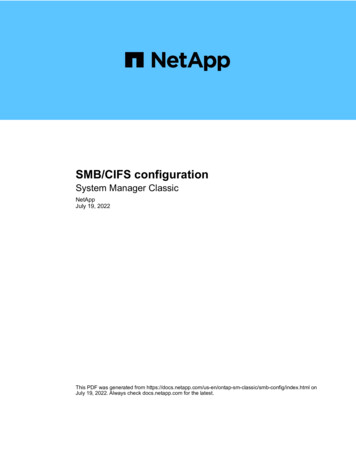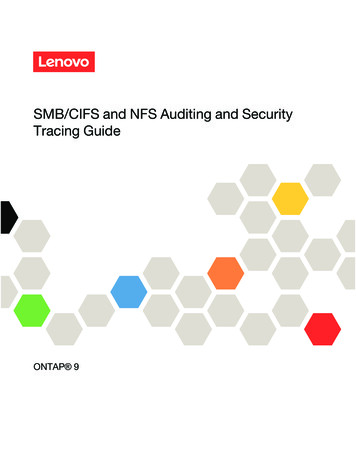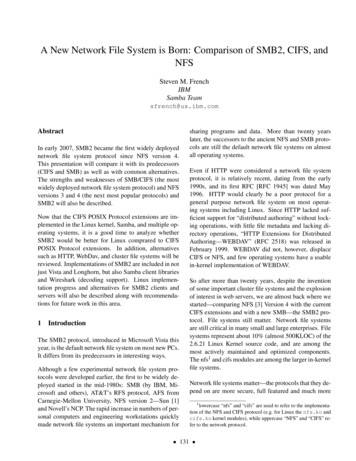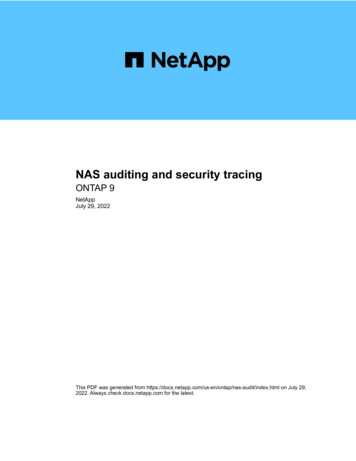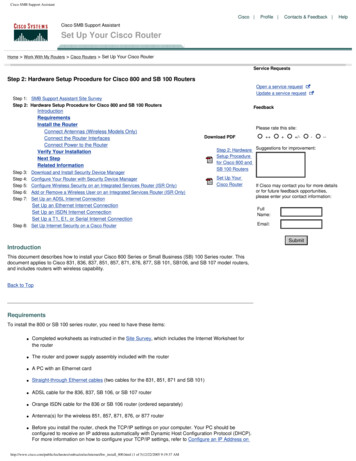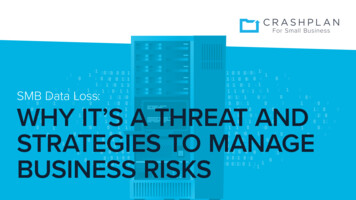
Transcription
For Small BusinessSMB Data Loss:WHY IT’S A THREAT ANDSTRATEGIES TO MANAGEBUSINESS RISKS
Executive SummaryWith data making up the foundations of today’s companies, any loss or downtimeincident can have serious consequences for a small business.Although backup strategies continue to improve – moving away from physical storagetowards the cloud – even these more advanced solutions fail to prevent data lossthrough common issues such as accidental overwrites and other user errors.While SMBs were previously regarded as too small and unimportant to be targetedby hackers, their consequent failure to recognize the value of their data and investin appropriate IT resources and training means that they are now overrepresentedin cyberattacks. Furthermore, when SMBs suffer data loss incidents, they aredisproportionately affected by the impacts of downtime, lost revenue and damagedbrand reputation compared to larger businesses.ALTOGETHER, THE QUESTION IS NOT IF, BUTINCIDENTS WILL OCCUR.WHEN DATA LOSS37%of SMBs have reported losing data saved in the cloud1Only 22%of small business employees reported thattheir company compelled its staff to use a password manager266%of SMBs reported that a data loss incident would cause themto shut down for at least a day, or even put them out of business altogether3Accordingly, it is vital for SMBs thatthey plan a secure data protection strategy to safeguard their business.39%of SMBs admitted that they would be prepared to handover “almost any price” if they suffered a ransomware attack42
Current state of the industry:VALUE OF DATAWith the creation and use of data being at the core of most businesses – fromcustomer information to intellectual property to financial reports and projections– any significant loss of this information can have a critical impact. THISESSENTIAL ASSET IS CONSTANTLY AT RISK FROM DANGERS AS DIVERSE ASRANSOMWARE, HARDWARE FAILURE, USERMISTAKES OR EVEN NATURAL DISASTERS.Regardless of the cause, data loss can be incredibly costly – especially for smallbusinesses. Sums demanded in a ransomware attack, for example, average 4,200 USD per user at a small company.5 In addition, the damage data loss causesa company extends far beyond the alarming headlines of cash payments paid 011011013
BACKING UP FILESWhen it comes to protecting important files, businesses have customarily dependedon creating backups that can be retrieved should they experience a data lossincident. Because backups made to physical hard drives stored in the same locationleave data at risk of being wiped out entirely by natural disasters, theft, or otherlocation-based incidents, cloud-based solutions are becoming the new norm.This often leads businesses to turn to cloud storage and cloud collaboration toolslike DropBox and OneDrive. While they are cloud-based, these file sharing andcollaboration tools should not be viewed as a solution for protecting valuablecompany data. Using them to store files is dependent on employees proactivelysaving their work to a designated location, a step that is all too easy for users toforget. In addition, accidental overwrites and user errors – the most frequent causeof cloud data loss in the workplace6 – remain a problem. And, when an SMB is hitwith a virus or malware attack, the malicious software is quickly spread throughoutthe organization via the cloud. Unsurprisingly, 37% of SMBs have reported losingdata saved in the cloud.7ALONGSIDE RELIABILITY IS THE ISSUE OF COVERAGE.Since small business employees increasingly use a variety of personal laptops andother private devices for day-to-day tasks, cloud collaboration tools that only copyfiles from a folder on company-owned device risk missing key files.4
EVOLUTION OF RISKS OF DATA LOSS TO SMBSAs data has grown rapidly in value in recent years, SMBs are increasingly viewed bycyber criminals as a valuable and often-exposed source of corporate and personalinformation.In the past, SMBs’ relative lack of capital and lower public profile meant that theywere frequently spared from the bulk of advanced cyberattacks.8 UNFORTUNATELY,THE COMBINATION OF ASSUMING THAT THEY ARE UNATTRACTIVE TOCRIMINALS ALONG WITH THEIR LESS-SOPHISTICATED IT RESOURCES HAS SEENTHEMBECOME A PRIME TARGET FOR ATTACKS.58%of companies that suffer cyberattacks todayare classified as small businesses.9 For ransomware, thisfigure rises to 71%.105
SMBS ARE FALLING BEHINDSMBs’ limited IT budgets and failure to recognize their increasing vulnerability hasled to many neglecting to properly invest in IT security, and consequently seeingthemselves fall further behind better-prepared larger businesses.11 This gap inIT skills and resources means that smaller businesses are left to rely upon theiremployees’ own confined understanding of cybersecurity.1218%Onlyof SMBs in the United States provide employeeswith regular IT training in order to help prevent cybercrime.13Established password policies, for example, are a common weak point for SMBs:Only 22% of small business employees reported that their company compelled itsstaff to use a password manager. Likewise, 67% of employers agreed that personnelusing weak passwords was a considerable burden to their business,14 leaving themvulnerable to ransomware attacks.Number and increased frequency of attacks47%of small businesses in the US and a number of Europeancountries were victims of a cyberattack between 2017 and 2018.15Among these victims,44% had been exposed to 2 to 4 attacks during that period, while8% had suffered 5 or more.16In 2018, incidents among small businesses rose year-over-year by 59%,averaging62 per day.1798%of SMB owners reported that cybercrime was athreat to their businesses, with 25% and 46% reporting thatthey saw it as a major or moderate threat respectively.186
REMOTE WORK AND THE RISK OF DATA LOSSThe growth of remote work is particularly relevant to smaller businesses, whobenefit from the increased flexibility and easier engagement with freelancers.With 99% of respondents to a 2019 Buffer survey revealing that they wish to workoutside of the office at some point during the remainder of their career,19 remotework is a trend that will be at the core of SMBs’ business model for the foreseeablefuture.WITH THE GROWING POPULARITY OF REMOTE WORK, IT PRESENTS A RANGE OFNEW CHALLENGES FOR BUSINESS’ DATASECURITY.On a practical level, for example, remote work inevitably leads to a rise inemployees losing work devices or other company property. Loss of portable devicesis responsible for almost as many data loss incidents as hacking or malware.20 Andthe problem is not going away anytime soon.With Millennial and Gen Z employees expected to account formore than half of the workforce in 2028 (58%), it is forecast thatof teams will include remote staff.2173%7
THE POTENTIAL IMPACT OF DATA LOSS INCIDENTS ON SMBSIn spite of the fundamental role reliable access to key data has in the modernworkplace, SMBs are frequently guilty of not fully considering the impact of staffbeing locked out of their files when developing data protection policies.Unfortunately, among SMBs that do pay a ransom following an attack, almost onein five (18%) never recover their data. Furthermore, fewer than 33% of incidentssuffered by SMBs are reported to the authorities.27In fact, when small businesses experience data loss, 80% of costs can be attributedto the decrease in employee productivity.22 A single hour of downtime can costSMBs as much as 8,600 USD, while an outage lasting a whole day can causedamages of up to 68,800 USD.23As a result, 66% of SMBs reported that a data loss incident would cause them toshut down for at least a day, or even put them out of business altogether.24 Whilethe standing of any company can be damaged by a data loss emergency, SMBs’size means that they are disproportionately affected by downtime and lost revenue.Furthermore, since they have a less-established reputation in the first place, manynever regain clients’ trust following the hit to their brand image.25And because of their more limited resources, SMBs are especially vulnerable to beingexploited in ransomware attacks. If their data was held hostage by cybercriminals,55% of small businesses reported that they would be willing to pay to get their filesback, a figure that rises to 74% among larger SMBs. Almost four out of ten (39%)admitted that they would be prepared to hand over “almost any price” in such anevent.26CLOSEDCLOSED8
Protecting data in an increasingly dangerous climate for SMBsRECOMMENDATIONSUltimately, for SMBs, the issue doesn’t come down to if they experience a damagingdata loss incident, rather a matter of when one will happen.As has become clear, with preventative security solutions only be able to limit therisks to small businesses while attacks are continually becoming more advanced,the focus needs to shift to the protection of data.Ultimately, protection against data loss, regardless of cause, will require a multipronged approach including user training and education, local backups for quickrestores when hardware is lost or damaged, and a cloud-based backup solution toprotect against outside threats such as ransomware, theft, or extreme weather event.The data protection approach recognizes the constant dangers to SMBs and, instead ofrelying upon daily backups to an in-office server or hard drive, copies data to the cloudautomatically as frequently as every half hour. This ensures that, regardless of whethersystems are affected by ransomware, physical damage, hardware failure or, veryfrequently, user mistakes, no more than 30 minutes of a business’ work will be lost.28By storing data in the cloud, files are physically safe from day-to-day physical ortechnology-related disasters, while also ensuring that backups can be accessed easilyfrom outside the office – a solution tailor-made for the modern, flexible workplace.A data protection-focused strategy addresses SMBs’ limited IT security resourcesby ensuring that backup and recovery is user-friendly and efficient. Since backupsare made automatically, smart security practices are no longer dependent on userbehavior or work style preferences. Cloud-based data protection systems aredesigned to be deployed easily in a day or two, while a fast, self-service restorationmeans that a company’s up-to-date files can be retrieved without the help of IT.9
Endnotes1“The Perfect Guide to Data Loss Protection”, www.crashplan.com, July 20192 “2018 State of Cybersecurity in Small & Medium Size Businesses”,www.keepersecurity.com, November 20183 “VIPRE Announces Launch of VIPRE Endpoint Security – Cloud Edition”,www.businesswire.com, October 20174 “Majority of SMB Leaders Say They Would Pay Ransom to Have Stolen Data Returned”www.appriver.com, April 20195 “The Cost of Data Loss to Your Small Business”, www.avg.com, June 20186 “2019 Global Encryption Trends Study”, www.ncipher.com, August 20197 “The Perfect Guide to Data Loss Protection”, www.crashplan.com, July 20198 “Why Your Business Might Be a Perfect Target for Hackers”, www.inc.com, December 201415 “2018 HISCOX Small Business Cyber Risk Report”, www.hiscox.com, January 201816 “2018 HISCOX Small Business Cyber Risk Report”, www.hiscox.com, January 201817 “SiteLock 2019 Website Security Report”, www.sitelock.com, August 201918 “Risk of Cybercrime to SMEs in the U.S. 2016”. www.statista.com, October 201619 “State of Remote Work”, www.buffer.com, August 201920 “Follow the Data: Dissecting Data Breaches and Debunking Myths”,www.trendmicro.com, July 201921 “Third Annual ‘Future Workforce Report’ Sheds Light on How Younger Generations areReshaping the Future of Work”, www.upwork.com, March 201922 “Business Continuity: Understand Your Risks from Data Loss”, www.crashplan.com, July 20199 “2019 Data Breach Investigations Report”, www.enterprise.verizon.com, July 201923 “Report Identifies Ransomware’s Biggest Cost to be Business Downtime”,www.prnewswire.com, March 201610 “71% of Ransomware Attacks Targeted Small Businesses in 2018”,www.healthitsecurity.com, March 201924 “ VIPRE Announces Launch of VIPRE Endpoint Security – Cloud Edition”,www.businesswire.com, October 201711 “The Most Effective Ways to Protect Your Small Businesses From Cyber Attacks”,www.smallbiztrends.com, January 201925 “Business Continuity: Understand Your Risks from Data Loss”, www.crashplan.com, July 201912 “3 Reasons Why Hackers Like to Target Small Businesses”,www.pacetechnical.com, August 201913 “U.S. SME Protections Against Cybercrime 2016”, www.statista.com, October 201614 “2018 State of Cybersecurity in Small & Medium Size Businesses”,www.keepersecurity.com, November 201826 “Majority of SMB Leaders Say They Would Pay Ransom to Have Stolen Data Returned”,www.appriver.com, April 201927 “Datto’s State of the Channel Ransomware Report EUROPE”, www.datto.com, August 201928 “What Does Data Loss Protection Mean for Small Business?”, www.crashplan.com, June 201910
About UsCrashPlan for Small Business is a product of Code42, an industry leader in data security, protecting thecritical data of more than 50,000 world-class organizations, including the largest global brands. Hosted onCode 42’s enterprise-grade secure cloud system, CrashPlan for Small Business‘ automatic backup solutionis specifically designed to meet the needs of SMBs. We help small businesses and organizations recover andbounce back faster from data loss incidents, whether caused by natural disaster, simple human error, a stolenlaptop, ransomware and more.CrashPlan for Small Business provides peace of mind through easy-to-use, unlimited automatic data lossprotection. In the event of an incident, CrashPlan’s automated data protection reduces the amount of potentiallost work to as little as 30 minutes. And restoration of user data can even be done by users themselves –limiting the burden on IT. Signup is fast and easy, and you’ll enjoy peace of mind knowing your data – andyour business – is protected. Use this link to get started protecting your business with CrashPlan for SmallBusiness.For Small Business
1 "The Perfect Guide to Data Loss Protection", www.crashplan.com, July 2019 2 "2018 State of Cybersecurity in Small & Medium Size Businesses", www.keepersecurity.com, November 2018 3 "VIPRE Announces Launch of VIPRE Endpoint Security - Cloud Edition", www.businesswire.com, October 2017
